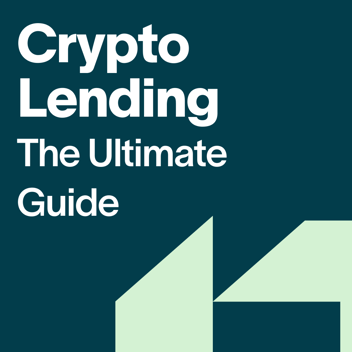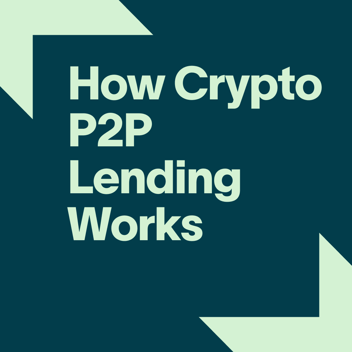The Risks Of Crypto Lending
.png?width=1600&height=900&name=Crypto%20Lending%20Risk%20(1).png)
Cryptocurrencies are widely recognized as an important asset class. Like many assets, crypto can be lent, borrowed, and used as loan collateral. Crypto lending offers competitive interest rates, easy access to lending and borrowing services, and the opportunity to earn passive income, or access cash, without selling your crypto.
However, the recent liquidity crises that led to the downfalls of platforms such as Blockfi and Celsius might make you hesitant to start lending your crypto.
Related Content: How to Refinance Your Celsius Loan
It’s understandable, and even sensible, to be concerned about the safety and risks associated with lending in the crypto space. That said, the collapse of these platforms, and the subsequent lawsuits from regulatory bodies against Celsius and its former CEO, Alex Mashinsky, may make this kind of lending safer in the long term. But even if it doesn’t have any regulatory impact, there are several low-risk options available.
In this blog, we'll take you through the risks of crypto lending, and explore the safest options available.
What is crypto lending?
Crypto lending is a way to earn interest in-kind from cryptocurrencies without dealing with market volatility. It enables you to earn passive interest by lending your crypto assets, usually via a platform. Instead of leaving your crypto assets in your wallet, you lend them to borrowers who are willing to pay interest in exchange for access to those assets.
Crypto-backed loans can be viewed as a subset of crypto lending. They enable you to borrow money or stablecoins using your crypto as collateral. You benefit from the value of your crypto holdings without selling them. Instead, you deposit your crypto into a lending platform or service, which then provides you with a loan in your desired currency. The loan amount is determined by the value of your collateral. When you pay back the loan, plus the interest, you get your collateral back.
Our guide ‘How to Borrow Against Crypto - Decoding Crypto Loans’ tells you everything you need to know about lending your Bitcoin and other crypto.
How Does Crypto Lending Work?
You transfer your crypto to a lending platform. In return, you receive regular interest payments.
Here’s how that might work: You decide to lend 2 Bitcoin to a crypto lending platform for 90 days at a 6% interest rate and deposit such assets in a BTC savings account. An institutional borrower borrows the BTC, using collateral, for short-term opportunities. After 90 days, the institutional borrower returns the 2 BTC along with the 6% interest, allowing you to earn a passive income while holding onto your BTC savings or growth account.
Crypto-backed loans work in a similar way. You transfer your crypto to a lending platform, and in return, you receive a loan in fiat currency or stablecoins, usually within a day or less. The size of the loan is determined by the value of your collateral. You can do anything you like with this money. Once you repay the loan and the interest on it, you get your crypto back. In the event of non-payment, lenders can liquidate the collateral to recover their funds.
.png?width=1600&height=900&name=Guide%20To%20Crypto%20Lending%20(2).png)
For a more comprehensive guide to crypto lending, check out our blog ‘Ultimate Guide to Crypto Lending’.
Is Crypto Lending Safe?
Crypto lending comes with varying levels of risks. These differ according to the platform and product you select.
While some platforms offer higher returns, they also come with higher risk exposure. Peer-to-peer (P2P) lending, for instance, is considered higher risk due to the lack of institutional oversight and the chance of borrower defaults. On the other hand, crypto savings accounts offer lower returns but provide more security and stability.
Of course, no crypto lending, and indeed any lending, is entirely risk-free. Even the safest loans carry a small level of risk.
The 4 Main Risks With Crypto Lending
Before you get started with crypto lending, it's important to understand the potential risks involved. In this section, we'll explore the key risks, so you can make informed decisions.
Lack of Legal Clarity
Crypto regulations are still in their infancy. The lack of clear regulatory frameworks can be confusing for lenders and borrowers alike. While some countries have now clearly defined their stance on cryptocurrencies, the global regulatory landscape remains complex. Generally, crypto lenders tend to have less oversight than traditional banks. However, future regulations could change this.
The collapse of cryptocurrency exchange FTX in November 2022 raised concerns among North American regulators over the regulation of cryptocurrencies. Although there is uncertainty over whether crypto is a security or commodity, and therefore even with regulators’ remit, "regulation via enforcement" approaches are becoming more common. As a result, several crypto players, including Coinbase and Ledn, have sought regulatory approval in jurisdictions outside the US where regulatory frameworks are more defined.
Insolvency risk
One risk of crypto lending is the possibility of losing part or all of your funds if the platform you select goes bankrupt.
When you lend your crypto to a platform, you trust them with your assets. There's a possibility that the platform may face financial instability or operational issues, leading to insolvency.
In the event of a platform going bankrupt or unexpectedly shutting down, investors may lose part or all of their funds.
In the last year, a number of crypto companies filed for bankruptcy, including FTX, Alameda, Three Arrows, Core Scientific, Celsius Network and Voyager Digital.
Regulatory oversight and robust risk management protocols reduce the risk of financial pressures and fraud.
We’d recommend conducting thorough research before transferring any assets to a crypto lending platform. Look for platforms that are well-established, transparent about their financial health, and have a proven track record of successfully managing borrowers' collateral and investors' funds. At Ledn, we've removed insolvency risk from our savings experience by ring-fencing our new Growth Accounts.
Proof-of-Reserves attestations are worth looking into, too. These procedures are carried out by an independent public accountant, who reviews asset balances, as well as lending and custodial balances. Not only do they demonstrate that platforms are properly accounting for their clients’ assets, they also show total assets versus total liabilities, and provide transparency over where users’ crypto is. This helps avoid liquidity crises if customers withdraw funds en masse.
Fees are not always transparent
Some platforms may have hidden fees that can significantly eat into your profits. Carefully review the fee structure of any platform before lending your cryptocurrencies.
DeFi rug pulls
Decentralized Finance (DeFi) platforms have gained popularity in recent years, but they come with their own set of risks. A rug pull is an exit scam associated with this type of platform. Scammers artificially inflate a new token's value, only to vanish with the funds, leaving investors with a worthless asset.
Related content: CeFi vs DeFi - Key Differences Explained
Security breaches
Cybercrime and hacking are risks. If a security breach leads to the loss of your funds, there is no guarantee of compensation.
Volatility
The value of your assets might drop while you’re lending them out.
If you take out a loan, and the value of your collateral drops, you might have to add more crypto collateral.
Borrowing against more stable and established cryptocurrencies like Bitcoin and Ethereum can lower this risk.
Benefits of Crypto Lending
Keep the above risks in mind, but don’t let them deter you from lending your crypto, especially if you own reliable assets such as Bitcoin or Ethereum. Established, reputable platforms that will help you minimize risks. The way you choose to lend your crypto will depend on your risk tolerance and the return you are looking for.
In this section, we’ll run through some of the benefits of crypto lending.
Earn Passive Income
By lending your cryptocurrencies, you can earn interest on your holdings without doing anything. Rates are often higher than traditional savings accounts.
Competitive Interest Rates
If you’re lending your crypto, the interest rates you receive are likely to be higher than traditional savings accounts. The average rate on savings accounts in the US is currently just 0.42%. With Ledn’s Growth accounts, you can earn up to 9.00% APY.*
On the flipside, if you’re using your crypto as collateral to take out a loan, interest rates are likely to be significantly lower than other traditional financing options, such as payday loans or credit cards. Our blog ‘Best Bitcoin Loan Rates In 2023’ goes into this in more detail.
Loan Terms are Flexible
Unlike traditional investment options, crypto lending comes with a high degree of flexibility and liquidity. You can choose the lending term that suits your needs, ranging from short-term to long-term. If you take out a loan, you can have flexible repayment terms, allowing you to access your money when needed.
Barriers to Entry are Low
Crypto lending platforms generally have low minimum investment requirements.
High Levels of Privacy
Crypto lending and loans offer a greater level of privacy compared to traditional finance. Traditional loans require extensive personal and financial information. Crypto loans only require your crypto collateral. This helps protect your privacy and personal data.
No Credit Checks
Crypto loans are collateral-based. This eliminates the need for traditional credit checks, making the lending process more accessible and less restrictive.
Borderless Transactions
Crypto lending transcends geographical boundaries, enabling borrowers and lenders from different parts of the world to participate. This accessibility opens up opportunities for people who might not be able to take out a traditional loan due to their location, credit history, or lack of traditional assets.
The Safest Way to Lend Crypto
Lending for Passive Income (AKA Saving)
Accessible and flexible crypto savings accounts are the safest way to lend your crypto if you’re looking to earn passive income.
When you deposit your crypto assets into a savings account, the platform lends those assets to borrowers and pays you interest on your holdings. Interest rates are determined by factors such as the lending platform's business model, market conditions, and the type of cryptocurrency you deposit.
Crypto savings accounts are often provided by centralized exchanges, lending platforms, or dedicated crypto platforms. The best platforms offer account management tools, user-friendly interfaces, and the ability to easily deposit or withdraw funds.
These accounts mitigate the majority of the risks mentioned earlier, providing investors with more stability and security. Ledn’s BTC and USDC Growth accounts have a transparent fee structure and enable you to earn up to 10% APY.
Lending for Loans (AKA Borrowing)
If you decide to use your crypto as loan collateral, select a platform that is well-established, transparent about its financial health, and has a proven track record of successfully managing funds. Proof-of-Reserves attestations, done by an independent public accountant, demonstrate a gold standard for transparency and reliability.
Conclusion
Whether you are looking to generate passive income from your crypto, or take out a crypto backed loan, crypto lending offers many advantages. Minimize risks by assessing your risk tolerance and exploring the options available. Always do your research and stay informed about the latest developments in the crypto lending space.
Learn more about crypto lending with our blog series, or secure your assets with a Ledn Growth account.
Sponsored by 21 Technologies Inc. and its affiliates (“Ledn”). All reviews and opinions expressed are based on my personal views. * Digital assets savings accounts are not guaranteed by any entity and are not covered by any government deposit insurer or investor protection against losses anywhere in the world.




